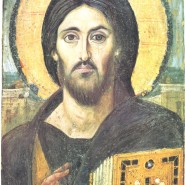BY MARTY KLINKENBERG, EDMONTON JOURNAL
EDMONTON – While visiting a fellow clergyman in Philadelphia a few years ago, David Motiuk saw for the first time a replica of the Shroud of Turin.
The bishop for Alberta’s Ukrainian Catholics, Motiuk was moved by the reproduction of a cloth many Christians believe was used to wrap Jesus of Nazareth’s body after it was removed from the cross.
“The best way to describe it is that most of us think of God as being distant and divine,” Motiuk said this week at St. Josaphat Cathedral. “But when you see the shroud, you see the human suffering of a God that is close to us. God is no longer distant to me.”
Two years ago, Motiuk wrote the Archbishop of Turin, custodian of the original shroud, to ask if one of its handful of authorized facsimiles could be sent for display. Instead, one was given to the Edmonton Eparchy, and will be featured during a special Good Friday service at St. Josaphat’s at 11 a.m.
After that, the cloth will rest in a tomb at the front of the church during an all-night prayer vigil, and will be moved to the foot of the altar by the time congregants arrive Sunday morning for Mass.
“We are very privileged to have this,” Motiuk said. “There are so many things we have read about Christ’s crucifixion that are mirrored in the shroud.”
A woven sheet that bears the faint impression of a man who was crucified, the Shroud of Turin is clouded in mystery and subject to debate. Scientists have been unable to explain the blood-stained image, and tests conducted on the cloth have led to wildly different conclusions — that it either originated in the Middle Ages or dates to 280 BC to 220 AD — with a possible margin of error of 250 years.
“It is a wonderful piece where faith and science are called together to challenge one another,” Motiuk said.
While the Catholic Church has neither acknowledged nor denied its authenticity, then Pope John Paul II called it a mirror of the Gospel, and Popes Benedict and Francis described it as an icon.
After receiving the replica earlier this year, St. Josaphat’s placed it on exhibit and will do so again following the Easter holidays. Future plans also call for it to be taken on a tour of Ukrainian Catholic churches across Alberta.
The exhibit includes a photographic display which makes it easier to identify the wounds that were inflicted on the man depicted on the shroud. The body appears to have received a severe lashing and piercings of the feet and wrist. There is evidence of bleeding and thorn fragments in the scalp, and a penetration wound of some sort exists between the fifth and sixth ribs.
Father Peter Babej, rector at St. Josaphat, said he enjoys seeing people’s reaction to it.
“At first they don’t understand what they are seeing,” said Babej, who was born in Toronto and ordained in Ukraine. “But then there is a progression of understanding in appreciation and faith.”
SHROUDED IN MYSTERY
The Shroud of Turin is believed by many Christians to be the cloth with which Jesus of Nazareth was wrapped following the Scrucifixion. The matter is subject of debate between scientists, historians and theologians.
The shroud is a rectangular linen sheet woven in a herringbone pattern consistent with ancient Egyptian style used before and after the time of Christ. It measures approximately 4.5 metres long and 1.2 metres wide.
Since 1578, the shroud has been kept almost uninterruptedly in the Cathedral of Saint John the Baptist in Turin, Italy. Much of its history before the late 14th century is unknown.
Scientific analysis has concluded the image was not produced by an artist using paints or dyes, and the cloth has been in direct contact with a human body, which explains certain features such as scourge marks and blood. How the image was produced remains a mystery.
The Archbishop of Turin, the custodian of the original shroud, has authorized only a handful of reproductions, including the one that now belongs to the Ukrainian Catholic Eparchy of Edmonton.
Other than this weekend, the scheduled public exhibition of the replica will take place at St. Josaphat Cathedral from May 6 to Aug. 10, on Tuesdays and Thursdays from 6 p.m. to 8 p.m. and Sundays from 1 p.m. to 4 p.m.
The cathedral is in Edmonton, just north of Chinatown, at 10825 97th St.

